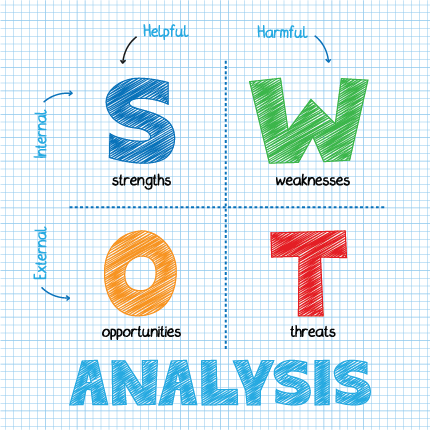In a world of organizational paradigms, most of the companies that start out or some of the old companies that fail – they do so because they don’t know their own potential. At times, such businesses overestimate their resources.
When there is no proper estimation of all of your troops, you can never accomplish anything as a company. This is why you need a proper estimation of your team, your resources and your recognition in the market before embarking on a new project.
In this article, we will teach you what actually is a SWOT Analysis, how you can actually conduct one and how can you achieve the most success by applying its benefits to the maximum in your activities. Let’s start from the beginning.
SWOT Analysis
So what exactly is a SWOT Analysis? Well, SWOT stands for Strengths, Weaknesses, Opportunities, and Threats. These are all of the analysis checks that your company has to go through if it wants to succeed in the market.
You can use this analysis to optimize your company’s output by finding out its exact potential and make the best of what you’ve got. This will help you reduce the chances of failure in the future by understanding what you’re shortcomings are and eliminate all of the scope creeps that can be deadly.
When you have all of your cards in play and are transparent about your potential, you can effectively build a strategy that sets you apart from all of your competitors and fight head-on with them in the open market.
Let us now move on to how you can perform a successful SWOT Analysis of your business.
How to Perform a SWOT Analysis?

To effectively perform a SWOT Analysis, you need to draw up an Analysis matrix that consists of a 2×2 grid that has 4 sections, each for every element of SWOT (Strengths, Weaknesses, Opportunities, and Threats).
You can perform this analysis with two completely different perspectives. Either you can get your team together and perform the analysis as a kick-off strategy creation or you can use it as the formal tool that it actually is.
In either scenario, you should gather a team from all the 4 corners of the company. This team should consist of team members from various departments, so that you can brainstorm ideas off of them, to get an exact idea about where your company is currently standing.
During this activity, whenever you get to identify a potential Strength, Weakness, Opportunity or Threat to the company, you should write it down in the specified space on the SWOT Analysis matrix which we discussed earlier.
Most of the time we get bombarded with a lot of different ideas that can fall under multiple sections of the SWOT matrix.
In order to clarify which idea belongs to what column, think of strengths and weaknesses as your internal factors because they are related to all of the elements in the organization. That may include resources and team members etc.
Also, think of all of the opportunities and Threats as external factors come forward because of the company’s interaction with entities like its competitors, the market or the wider economy.
To make this process easier, let us now discuss the 4 elements that make up the SWOT Analysis.
Strengths

Strengths are those characteristics of your company that they do far more efficiently than any competitor out there. These are basically the distinguishing factors that separate them from everyone in the market.
Think of all of the good qualities and yield results your company has generated so far and put them in strengths. Why? Because anything positive can motivate your team to perform more productively. Strengths can also include a set of manufacturing processes or access to certain elements, all of which can set the company apart from everyone else.
When you are adding strengths to the matrix, just remember all of the properties of your company that makes it so lit, so appealing to the customers. Basically, anything that you do better than your competitors, drives in new business and uses the lowest number of resources, goes in the strength section.
Once you have done all that, turn your whole perspective and think about your business from the competitor’s eyes. You need to find out all of the elements in your strategies that the competitor might see as your strength.
You need to remember that, for anything to be considered a strength, it must bring your company a very clear advantage. For example, if all of your competitors are supplying high-quality items to the market, it’s not a unique strength if you do that too. It’s just a necessary criterion to be filled.
Weaknesses

When it comes to listing your weaknesses, you need to be very honest with yourself and list all of the possible weak points of your company that you can think of. What this will do is weed out whatever characteristics you have that can damage your company in the long run.
All of this makes it extremely vital that you be honest and embrace your weaknesses before you have to face any hardships or unpleasant truths along the way.
Weaknesses fall under the same generic category as your strengths do, i.e. internal factors. This means that to analyze and eradicate any potential weaknesses, you need to look at your own resources, people, procedures, and systems.
Think about all of the practices that you can adopt and the toxic ones you need to stay away from so that your company can eradicate its weaknesses and follow the path of improvement.
Opportunities

Opportunities are all of the practices and the potential production routes that you can adopt, in order to bring more value to the company. These opportunities arise from outside the company which makes this element of the SWOT analysis, one of the external factors for the company.
These opportunities present themselves in the very market you are a part of or in the technology that you use. To make yourselves better than your competitors, you need to be the best at spotting the potential opportunities as quickly as possible and make spontaneous decisions.
What those decisions will do is bring in more and more yield to your company and make you the leader of the market. Learn to separate the good from all of the bad opportunities.
When it comes to positive opportunities that you are sure that they will bring in positive change, size doesn’t matter. Whether big or small, you just need to make sure that they get implemented as soon as possible.
Threats

Threats are another example of external threats that can damage the business. These can include supply chain problems, shortage of recruits and drastic shifts in the market requirements. It’s very important for a successful business that the management anticipates all of the threats in the planning phase and be ready to block them from damaging the business.
You should keep in mind all of the obstacles that can potentially affect the business while you get your product to the market and start selling it.
You need to always keep a close eye on whatever your competitors are doing and what threats you need to diffuse if you want to challenge your competitors in the open market. This is all well and good, but you also need to make sure that what you are doing should bring a positive change to your company and not just copying your competitors because that strategy can prove to be fatal at times.
How to use the results of the SWOT Analysis that you performed?
Once you have acquired all of the results from the SWOT Analysis, you’ll be faced with a lot of options for the potential actions you can actually perform to help your business.
Based on the processes originated from the analysis, you’ll want to build on your strengths, head off any threats, make use of every positive opportunity and boost all of your weaker areas.
But before you apply any of the techniques that you think will be helpful, just take a step back and look for all the possible connections of the entries between the different sections of the matrix.
For example, various strengths can open many other opportunities or eliminating some threats can open up a whole load of different opportunities that would bring more yield to the company.
Conclusion
SWOT Analysis is a simple yet very powerful framework to analyze 4 of the most vital components of your company that can make or break your business. That’s why, while carrying out this analysis, you need to make sure that you are as realistic as possible and quite unforgiving when it comes to stating your weaknesses which will make this process successful and bring a very powerful change to your business.

